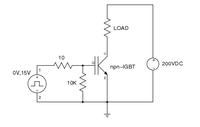oneprint
Newbie level 4

hi everybody,
i have a problem that i need some help with. i basically have a switching circuit which uses a 555 to switch an IGBT. this circuit is run using 18vdc. the IGBT switches a circuit that uses about 200vdc.
the problem i have is that the IGBT has to be ground on both circuits in order for it to work. that is the IGBT emitter is ground on both high and low voltage circuits.
I have not yet tested the high voltage side of the circuit. i did test with 23vdc as a substitute for the high voltage side of the circuit and everything works fine.
Can some one tell me if its ok to ground both circuits together i would have thought the low voltage power supply would be exposed to the 200vdc and that sounds dangerous!
can some tell me how to isolate the low voltage side of the circuit. I know about optocouplers but i dont realy want to use them. also both circuits are battery powered.
I hope some one can help. thanks in advance.
:smile:
i have a problem that i need some help with. i basically have a switching circuit which uses a 555 to switch an IGBT. this circuit is run using 18vdc. the IGBT switches a circuit that uses about 200vdc.
the problem i have is that the IGBT has to be ground on both circuits in order for it to work. that is the IGBT emitter is ground on both high and low voltage circuits.
I have not yet tested the high voltage side of the circuit. i did test with 23vdc as a substitute for the high voltage side of the circuit and everything works fine.
Can some one tell me if its ok to ground both circuits together i would have thought the low voltage power supply would be exposed to the 200vdc and that sounds dangerous!
can some tell me how to isolate the low voltage side of the circuit. I know about optocouplers but i dont realy want to use them. also both circuits are battery powered.
I hope some one can help. thanks in advance.
:smile:

